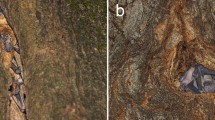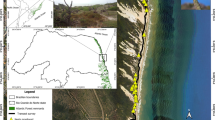Abstract
The phenomenon of partial migration in birds in which some individuals of a population are migratory while others stay in the breeding area is of increasing scientific interest. The strategies of partial migratory raptors from Central Europe are, however, unclear for most species. We analysed ring re-encounter data of Eurasian Sparrowhawks Accipter nisus and Common Buzzards Buteo buteo ringed in Germany in terms of distances and directions between ringing and re-encounter sites. We investigated possible differences between sexes (only in Sparrowhawks) and age classes, as well as effects of ringing region, seasonal weather (in the form of North Atlantic Oscillation indices) and long-term temporal changes (including climate change) on migratory strategies by means of generalized linear models. We found that, in both species, migration is mostly conducted by juveniles, although migratory adults were also found. In general, male Sparrowhawks tend to migrate less than females. Sparrowhawks from different regions showed no differences in migration activity and no responses to long-term temporal changes. They did not respond to seasonal weather either. Buzzards showed strong responses to winter weather (‘winter escapes’) predominantly in highland regions, and a reduction of migratory intensity probably due to global warming. We compared our results to ones for Common Kestrels Falco tinnunculus and found most similarities between Kestrels and Sparrowhawks.
Zusammenfassung
Ein Vergleich der Zugstrategien partiell ziehender Greifvögel aus Deutschland
Das Phänomen des Teilzugs bei Vögeln, bei dem ein Teil der Individuen einer Population zieht, während der andere Teil im Brutgebiet verbleibt, rückt immer stärker in den Fokus der Wissenschaft. Die Zugstrategien teilziehender Greifvögel aus Mitteleuropa sind jedoch für die meisten Arten noch unbekannt. Wir haben Ring-Wiederfunddaten von in Deutschland beringten Sperbern Accipiter nisus und Mäusebussarden Buteo buteo in Bezug auf Entfernung und Richtung analysiert. Wir untersuchten dabei mithilfe von Generalisierten Linearen Modellen mögliche Unterschiede zwischen den Geschlechtern (nur bei Sperbern) und Altersklassen, sowie den Einfluss von Beringungsregion, saisonalem Wetter (in Form von NAO-Indices) und Langzeitveränderungen (einschließlich des Klimawandels) auf die Zugstrategien. Wir fanden heraus, dass in beiden Arten hauptsächlich Jungtiere Zugvögel sind, es jedoch auch ziehende Adulte gibt. Generell ziehen männliche Sperber seltener als Weibchen. Sperber aus unterschiedlichen Regionen zeigen keine Unterschiede in der Zugaktivität und es gab keine Anpassungen an Langzeitveränderungen in unserer Studie. Auch eine Reaktion auf saisonales Wetter gab es nicht. Mäusebussarde hingegen zeigen eine starke Reaktion auf Winterwetter (‚Winterflucht‘) vorwiegend in den Mittelgebirgsregionen und einen Rückgang der Zugaktivität vermutlich aufgrund des Klimawandels. Wir verglichen unsere Ergebnisse mit denen, die bereits bei Turmfalken Falco tinnunculus gefunden wurden, und stellten die meisten Übereinstimmungen zwischen Turmfalken und Sperbern fest.








Similar content being viewed by others
References
Baier H, Erdmann F, Holz R, Waterstraat A (eds) (2006) Freiraum und Naturschutz—Die Wirkungen von Störungen und Zerschneidungen in der Landschaft. Springer, Berlin
Bairlein F, Dierschke J, Dierschke V et al (2014) Atlas des Vogelzugs–Ringfunde deutscher Brut- und Gastvögel. Aula, Wiebelsheim
Bauer HG, Bauer HG, Bezzel E, Fiedler W, Fiedler W (2005) Das Kompendium der Vögel Mitteleuropas. (Bd. 1: Nonpasseriformes). Aula, Wiebelsheim
Berthold P (2007) Vogelzug—Eine aktuelle Gesamtübersicht, 5th edn. Wissenschaftliche Buchgesellschaft, Darmstadt
Bladé I, Liebmann B, Fortuny D, van Oldenborgh GJ (2011) Observed and simulated impacts of the summer NAO in Europe: implications for projected drying in the Mediterranean region. Clim Dyn 39:709–727
Boyle WA (2011) Short-distance partial migration of Neotropical birds: a community-level test of the foraging limitation hypothesis. Oikos 120:1803–1816. doi:10.1111/j.1600-0706.2011.19432.x
Chakarov N, Jonker RM, Boerner M, Hoffman JI, Krüger O (2013) Variation at phenological candidate genes correlates with timing of dispersal and plumage morph in a sedentary bird of prey. Mol Ecol 22:5430–5440
Chapman BB, Brönmark C, Nilsson JA, Hansson LA (2011) The ecology and evolution of partial migration. Oikos 120:1764–1775. doi:10.1111/j.1600-0706.2011.20131.x
Federal Agency for Nature Conservation (2008) Daten zur Natur 2008. Landwirtschaftsverlag, Münster, pp 10–11
Fiedler W, Bairlein F, Köppen U (2004) Using large-scale data from ringed birds for the investigation of effects of climate change on migrating birds: pitfalls and prospects. In: Møller AP, Fiedler W, Berthold P (eds) Adv Ecol Res, vol 35. ELSEVIER Academic Press, Oxford, pp 49–67
Filippi-Codaccioni O, Moussus JP, Urcun JP, Jiguet F (2010) Advanced departure dates in long-distance migratory raptors. J Ornithol 151:687–694. doi:10.1007/s10336-010-0500-5
Folland CK, Knight J, Linderholm HW et al (2009) The summer North Atlantic oscillation: past, present, and future. J Clim 22:1082–1103
Forchhammer MC, Post E (2000) Climatic signatures in ecology. Trees 15:286
Forchhammer MC, Post E, Stenseth NC (1998) Breeding phenology and climate. Nature 391:29–30
Franke A, Therrien JF, Therrien JF, Descamps S, Descamps S, Bêty J (2011) Climatic conditions during outward migration affect apparent survival of an arctic top predator, the peregrine falcon Falco peregrinus. J Avian Biol 42:544–551. doi:10.1111/j.1600-048X.2011.05466.x
Ganey JL, Kyle SC, Rawlinson TA, Apprill DL, Ward JP Jr (2014) Relative abundance of small mammals in nest core areas and burned wintering areas of Mexican Spotted Owls in the Sacramento mountains, New Mexico. Wilson J Ornithol 126:47–52
Gauthreaux SA (1982) The ecology and evolution of avian migration systems. In: Farner DS et al (eds) Avian biology VI. Academic Press, London, pp 93–168
Glutz von Blotzheim UN, Bauer KM, Bezzel E (1971) Handbuch der Vögel Mitteleuropas, vol IV. Akademische Verlagsgesellschaft, Frankfurt am Main
Gwinner E (1990) Bird migration: physiology and ecophysiology. Springer, Berlin
Holte D, Köppen U, Schmitz-Ornés A (2016) Partial migration in a Central European raptor species: an analysis of ring re-encounter data of Common Kestrels Falco tinnunculus. Acta Ornithol 51:39–53
Hurrel JW (1995) Decadal trends in the North Atlantic oscillation: regional temperatures and precipitation. Science 269:676–679
Kalela O (1954) Populationsökologische Gesichtspunkte zur Entstehung des Vogelzugs. Ann Zool Soc Zool-Bot Fenn 16:1–30
Kania W (2009) Relative re-encounter ratio—an alternative approach to infer bird distribution from the re-encounter distribution. In: EURING Analytical Meeting 2009, Estimation, Modelling and Conservation of Vertebrate Populations Using Marked Individuals, p 89. http://www.wkania.eu/publikacje_z_zakresu,89.html
Ketterson ED, Nolan V (1976) Geographic variation and its climatic correlates in the sex ratio of eastern-wintering Dark-eyed Juncos (Junco hyemalis hyemalis). Ecology 57:679–693
Kjellen N (1992) Differential timing of autumn migration between sexes and age groups in raptors at Falsterbo, Sweden. Ornis Scand 23:420–434
Kjellen N (1999) Different migration strategies among Swedish Common Buzzars Buteo buteo revealed by the proportion of white birds. Ornis Svecica 9:11–18
Köppen U (2000) Zugtrieb oder Zugzwang? Über die saisonalen Wanderungen ostdeutscher Mäusebussarde Buteo buteo. Popultionsökol Greifvogel Eulenarten 4:179–195
Korner-Nievergelt F, Sauter A, Atkinson PW et al (2010) Improving the analysis of movement data from marked individuals through explicit estimation of observer heterogeneity. J Avian Biol 41:8–17
Kreiner A, Yemane D, Stenevik EK (2015) Spawning habitats of Cape Horse Mackerel (Trachurus capensis) in the northern Benguela upwelling region. Fish Oceanogr 24:46–55
Lehikoinen A, Saurola P, Byholm P, Lindén A, Valkama J (2010) Life history events of the Eurasian Sparrowhawk Accipiter nisus in a changing climate. J Avian Biol 41:627–636. doi:10.1111/j.1600-048X.2010.05080.x
Lensink R (1997) Range expansion of raptors in Britain and the Netherlands since the 1960s: testing an individual-based diffusion model. J Anim Ecol 66:811–826
Lund U, Agostinelli C (2012) S-plus original by Ulric Lund and R port by Claudio Agostinelli. CircStats: circular statistics, from Topics in circular Statistics (2001). R package version 0.2-4. http://CRAN.R-project.org/package=CircStats. Accessed 3 Feb 2016
Meller K, Lehikoinen A, Vähätalo AV (2013) The effects of hatching date on timing of autumn migration in partial migrants–an individual approach. J Avian Biol 44:272–280. doi:10.1111/j.1600-048X.2012.00016.x
Moritz D, Vauk G (1976) Der Zug des Sperbers (Accipiter nisus) auf Helgoland. J Ornithol 117:317–328
Newton I (2008) The migration ecology of birds. Elsevier, Amsterdam
R Core Team (2016) R: A language and environment for statistical computing. R Foundation for Statistical Computing, Vienna, Austria. https://www.R-project.org/
Rodewald PG, Brittingham MC (2007) Stopover habitat use by spring migrant landbirds: the roles of habitat structure, leaf development, and food availability. Auk 124:1063–1074
Ssymank A (1994) Neue Anforderungen im europäischen Naturschutz: das Schutzgebietssystem Natura 2000 und die FFH-Richtlinie der EU. Natur Landschaft 69(9):395–406
Strandberg R, Alerstam T, Hake M, Kjellen N (2009) Short-distance migration of the Common Buzzard Buteo buteo recorded by satellite tracking. Ibis 151:200–206
Thorup K, Korner-Nievergelt F, Cohen EB, Baillie SR (2014) Large-scale spatial analysis of ringing and re-encounter data to infer movement patterns: a review including methodological perspectives. Methods Ecol Evol 5:1337–1350
Vähätalo AV, Rainio K, Lehikoinen A, Lehikoinen E (2004) Spring arrival of birds depends on the North Atlantic Oscillation. J Avian Biol 35:210–216
Visser ME, Perdeck AC, van Balen JH, Both C (2009) Climate change leads to decreasing bird migration distances. Glob Change Biol 15:1859–1865. doi:10.1111/j.1365-2486.2009.01865.x
Author information
Authors and Affiliations
Corresponding author
Additional information
Communicated by N. Chernetsov.
Electronic supplementary material
Below is the link to the electronic supplementary material.
Rights and permissions
About this article
Cite this article
Holte, D., Köppen, U. & Schmitz-Ornés, A. A comparison of migratory strategies of partial migratory raptors from Germany. J Ornithol 158, 579–592 (2017). https://doi.org/10.1007/s10336-016-1419-2
Received:
Revised:
Accepted:
Published:
Issue Date:
DOI: https://doi.org/10.1007/s10336-016-1419-2




